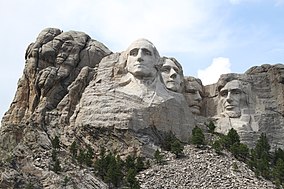
The most famous feature of Mt.Rushmore, is of course the presidential visages carved into it. But after the initial awe of seeing Lincoln, Roosevelt, Jefferson and Washington passed, I set up my rapelling supplies, and took a trip to Mr.Lincoln's forehead to examine the structure of the rock.

What I found upon analyzing a sample of the mountain was that the rock was Phaneritic in texture. The most common igneous rock with this texture are Granite, Diorite, Gabbro and Periodite. Fortunately, I never leave my house without a batman utility belt full of geologic supplies:
I first noticed that the crystals in this specimen were larger and very similar sized, which contributed to it's coarse texture. I was able to specifically identify with my trusty bat-handlens, two prominent minerals, Quartz and Feldspar, which indicates a felsic composition. The Quartz seemed glassy and round, and the feldspar crystals were grey and white in color. Using these attributes, I was able to identify one of the main elements of the mountain as Granite. The final giveaway was the light gray color overall, which while the least reliable way to identify, in conjunction with the others completed my analysis.
This tells us that one of the core components of this mountain likely cooled over a long period, forming slowly, in a slowly cooling magma in the Earth's crust, an intrusive rock!
After a full day of historical and geologic study, I re-packed my utility belt, and flew my ship back home to Pittsburgh.
No comments:
Post a Comment